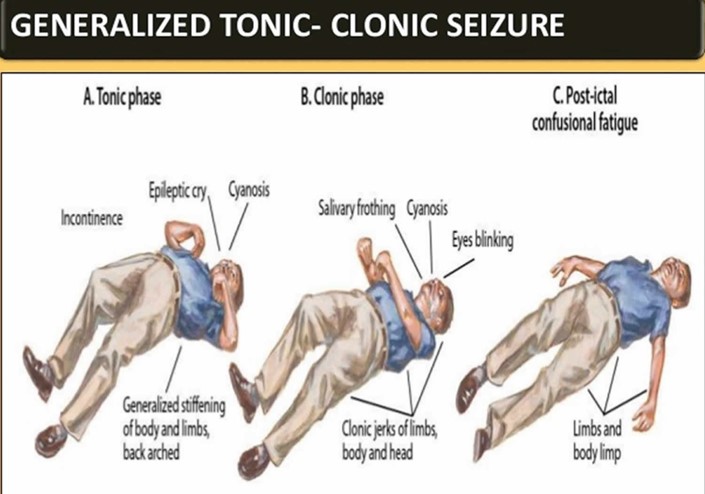The practical nurse (PN) is caring for a child who was admited after experiencing a generalized tonic-clonic seizure. When witnessing the child begin the seizure, what should the PN implement immediately? (Select all that apply)
Observe the progression of the seizure
Hold the extremities close to the body
Insert a tongue blade between the teeth
Pad the side rails with pillows
Loosen clothing around the neck
Correct Answer : A,D,E
The correct answers are:
a) Observe the progression of the seizure.
- Pad the side rails with pillows.
- Loosen clothing around the neck.
Explanation: During a generalized tonic-clonic seizure, it is important for the practical nurse (PN) to prioritize the safety and well-being of the child. The correct actions to implement immediately are:
a) Observe the progression of the seizure: The PN should closely observe the seizure to gather important information that can be helpful for medical professionals in assessing the seizure's characteristics and duration.
- Pad the side rails with pillows: Padding the side rails of the bed with pillows helps to prevent the child
from injuring themselves by hitting the side rails during the seizure.
- Loosen clothing around the neck: Loosening any tight clothing around the child's neck helps to ensure adequate breathing and prevent any constriction or discomfort during the seizure.
- Hold the extremities close to the body: This action is not recommended during a seizure as it may increase the risk of injury to the child or the PN.
- Insert a tongue blade between the teeth: It is not recommended to insert any object, including a tongue blade, between the teeth of a person experiencing a seizure. This can cause injury to the person's mouth or teeth and is no longer considered an appropriate intervention for seizures.

Nursing Test Bank
Naxlex Comprehensive Predictor Exams
Related Questions
Correct Answer is ["A","C","D","E"]
Explanation
Choice A rationale:
Verapamil is a calcium channel blocker and is expected to decrease heart rate by inhibiting calcium influx into cardiac cells, particularly in the SA (sinoatrial) node, where it can slow down the heart's electrical impulses.
Choice B rationale:
Increased contractility is not an expected outcome of verapamil use. In fact, verapamil's main action is to decrease myocardial contractility, making it useful for treating conditions like angina and atrial fibrillation.
Choice C rationale:
Verapamil is known to dilate coronary arteries, which can improve blood flow to the heart muscle and relieve symptoms of angina.
Choice D rationale:
Reduced blood pressure is an expected outcome of verapamil use due to its vasodilatory effects on peripheral blood vessels. This can be beneficial in treating hypertension and angina.
Choice E rationale:
Relieved chest pain is an expected outcome of verapamil use, particularly in the case of variant angina (Prinzmetal's angina), as it helps to relax coronary arteries and reduce coronary artery spasm, which is a common cause of chest pain in this condition.
Correct Answer is ["A","C","E"]
Explanation
C. Face the client when speaking.
E. Provide the daughter with written instructions.
Choice A rationale:
Including the family in the discharge teaching is essential, especially when dealing with a client who has communication barriers such as hearing loss and illiteracy. Involving the daughter in the teaching process ensures that she is aware of the client's care needs and can provide support at home.
Choice B rationale:
Encouraging the client to attend reading classes is not a practical intervention for an older adult with hearing loss. Reading classes may not address the immediate communication needs of the client, and the client's primary caregiver, in this case, is the daughter who will provide daily care and support.
Choice C rationale:
Facing the client when speaking is a crucial intervention when dealing with someone who has hearing loss. By facing the client, the nurse ensures that the client can see their lips and facial expressions, which can aid in lip-reading and understanding the communication better.
Choice D rationale:
Speaking loudly when teaching is not always the best approach for clients with hearing loss. While it may seem intuitive to speak loudly, it can distort speech and make it more challenging for the client to understand. Clear and slow speech, along with visual cues, is often more effective.
Choice E rationale:
Providing the daughter with written instructions is essential, especially when the client has limited reading skills. Written instructions can serve as a reference guide for the daughter, helping her provide care and support to her father accurately.
Whether you are a student looking to ace your exams or a practicing nurse seeking to enhance your expertise , our nursing education contents will empower you with the confidence and competence to make a difference in the lives of patients and become a respected leader in the healthcare field.
Visit Naxlex, invest in your future and unlock endless possibilities with our unparalleled nursing education contents today
Report Wrong Answer on the Current Question
Do you disagree with the answer? If yes, what is your expected answer? Explain.
Kindly be descriptive with the issue you are facing.
